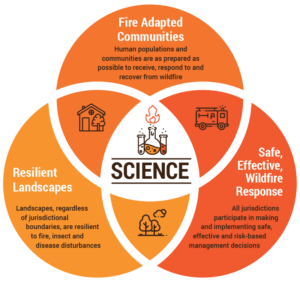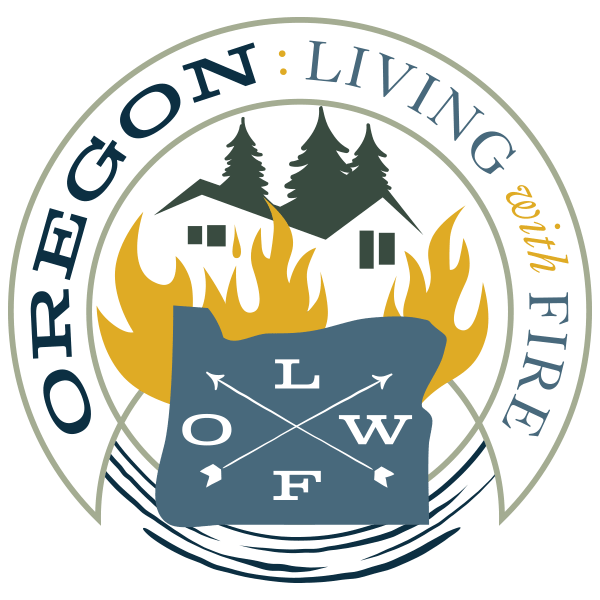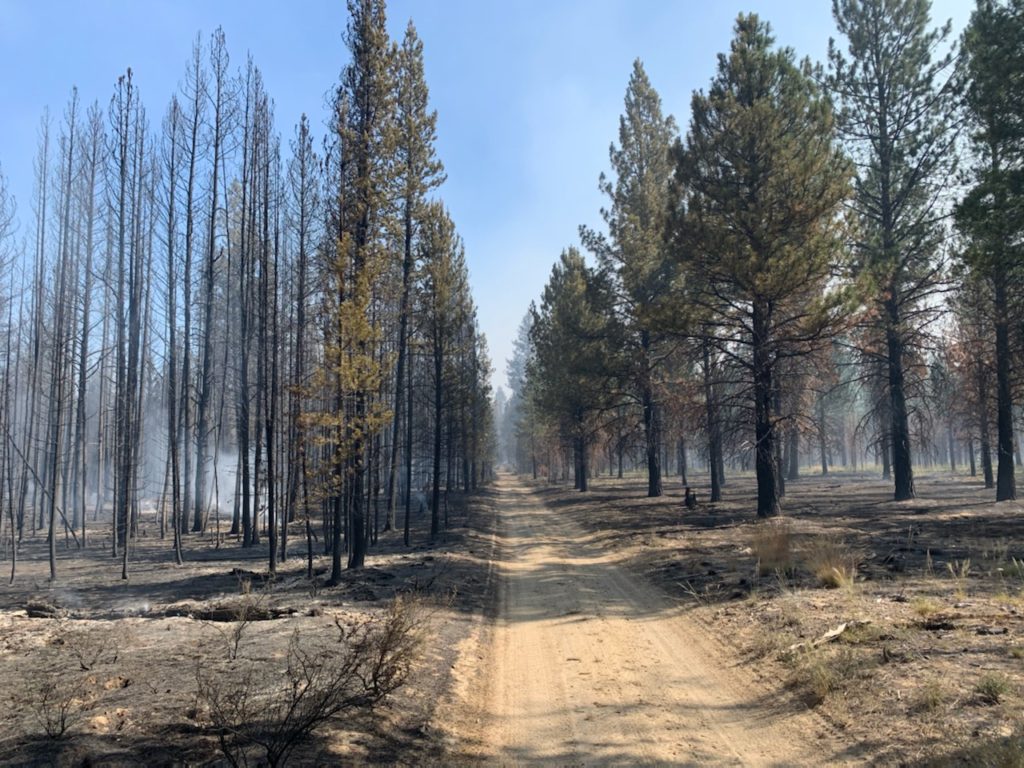The National Cohesive Wildland Fire Management Strategy, or Cohesive Strategy, is a national framework that can take many forms in our landscapes in the West. The three legs of the Cohesive Strategy are: Creating and maintaining resilient landscapes, creating and maintaining fire adapted communities, and implementing safe and effective wildland fire response. By working strategically on these three legs, we can be better prepared to live with wildland fire in the future. Central Oregon had a local example this summer that illustrates how long term strategic action can lead to real-world successes.

The Rosland Road fire burned 393 acres directly next to a La Pine neighborhood, Newberry Estates. There was certainly potential for this wildfire to impact the built environment, but a few key actions by local partners and residents well ahead of the firefight led to a successful outcome.
The local firefighting resources shared that they were able to be successful in suppressing the Rosland Road Fire due to a prescribed burn that occurred in the spring of 2019. The Rosland Road Fire provides a striking example of how fuel treatments like thinning, mowing, and prescribed fires help reduce the intensity of a wildfire even during fire weather conditions. Prescribed burns don’t happen in a vacuum; when they are implemented there are years of planning and pre-work that happens to ensure the burns are successful.

Local experts, partners, and fuel specialists have been working to place fuel treatments in strategic areas near communities to restore landscape health, protect communities and firefighters. Fuels treatments don’t always prevent a fire from happening, but this is a clear example of how they do help maintain healthier and more resilient forests when there is a wildfire. Prescribed fires are the final step in landscape restoration that can make the difference in a wildfire’s outcome.
The Rosland Road fire occurred directly next to the Newberry Estates neighborhood in La Pine, OR. The neighborhood had been working on their own defensible space and landscape management throughout the years. Along with work private landowners have been undertaking for years, the community was able to participate in a curbside chipping project in 2018 with some grant funding through Project Wildfire.
Both the work on the private and public lands was prioritized through the robust Greater La Pine Community Wildfire Protection Plan, which is updated on a 5-year cycle. Community Wildfire Protection Plans are in place to communicate areas of risk the community has identified to land managers and decision-makers. Our local public land managers then use those plans to prioritize adjacent fuel treatments and other organizations, such as Project Wildfire or Oregon Department of Forestry, can target at-risk areas with funding and education.
With human-caused starts on the rise and a lightning storm in August, Central Oregon has had a busy fire season. We have a long history of successful cooperative wildfire suppression in Central Oregon. Local resources have made a point to work better together rather than letting inefficiencies and egos get in the way of fire suppression. Our local firefighting agency leaders work tirelessly on planning and coordination year-round to ensure they can be as effective and safe as possible.
Both the work on private lands and fuel reduction on public lands don’t get accomplished without investment. Much of the work on all lands was funded through a private/public partnership called Joint Chiefs. The Joint Chiefs project recognizes that wildfire doesn’t respect lines on the map. In turn, the projects in Central Oregon strive to fund work in a strategic manner across boundaries and ownerships, our solutions can’t be boxed in by lines on the map.
Under an umbrella of active collaboration, private and public agencies, entities, groups, and individuals came together to address the three most prevalent challenges/goals across the La Pine landscape before there was smoke on the horizon. The actions of working across boundaries, personal responsibility, relationship building, and effective cross training. The three goals of Cohesive Strategy are interrelated and cannot be achieved in silos. Success stories such as the Rosland Road Fire provide a timely and measurable demonstration of the Cohesive Strategy at work.

